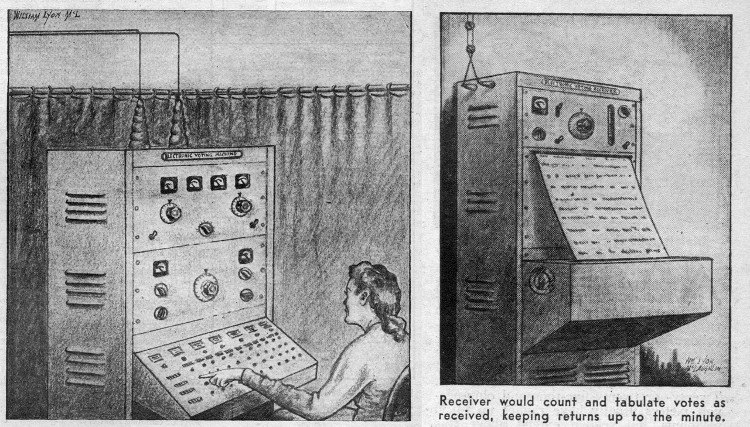The election machine has been around since the United States in 1945
Few people know that since 1945, the idea of a voting system has appeared, but at the time, it was considered an idea of filling and lack of practicality.
America is experiencing an unforgettable night in history when the 2016 presidential election campaign has the final result. However, it is rare to know that today's voting machine comes from an idea considered "crazy" , initiated in the 1945s.
Article titled "Votes by Radio: An Electronic Machine for Opinion Polls?" Radio-Craft magazine published in March 1945 proposed a completely new concept, about how people exercise their right to choose, safe and confidential at home - through push buttons.
Electrical engineer Alfred N. Goldsmith was the inventor of this machine system. They help send radio signals from households to the central radio transceiver center to produce the results table. Radio-Craft magazine even published the first sketches depicting the shape of "home voting machine" and "results center computer station".

Machines in the sketches are more massive than the present.(Photo: Gizmodo).
Accordingly, the principle of operation of the machine is explained by Goldsmith as follows:
First, the question will be communicated to people via radio at a specific location in the notified time frame. People will have a long enough time to think before making the final decision by pressing the button from the home control panel.
All questions asked must be in the form of a "Yes" - "No" question. There are a few exceptions with "Very good" or "Very bad" answers, but this rarely happens.
However, this seemingly perfect initiative is not easy to implement because not all families are eligible to equip these bulky machines at home. Many experts judged that Goldsmith's machines were not bad in terms of ideas, but lacked practicality. The right to choose if you have to spend money to buy will ultimately be affected by other objective factors such as old - young, rich - poor, career, gender or religion .
Today, the disadvantage has gradually been overcome thanks to the global network of computers connected to the Internet. However, the use of computers for political, economic, and even personal entertainment purposes is still very dangerous due to the potential for interference by bad groups.
- Voting machine in the US election
- American astronauts vote for president from space
- The machine will go to the battlefield
- The broad and serious impact of air pollution in the United States
- Tornadoes make dozens of casualties in the United States
- Typhoons devastated the United States, killing 159 people
- Small jets of water spray can cut off steel
- Measures to reduce mortality from cancer in the United States
- In 2029, the machine will be the same person!
- Splendid collection throughout the United States
- The eastern United States was paralyzed by the storm
- 'Vision machine' for people with poor vision
 'Fine laughs' - Scary and painful torture in ancient times
'Fine laughs' - Scary and painful torture in ancient times The sequence of numbers 142857 of the Egyptian pyramids is known as the strangest number in the world - Why?
The sequence of numbers 142857 of the Egyptian pyramids is known as the strangest number in the world - Why? History of the iron
History of the iron What is alum?
What is alum?